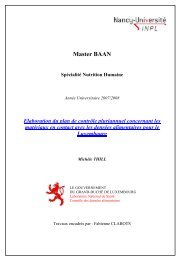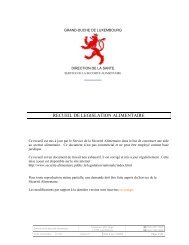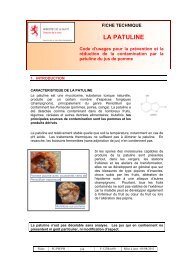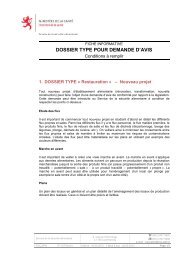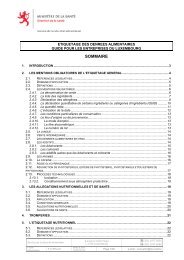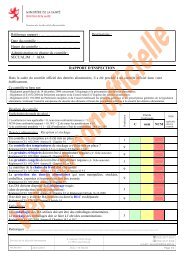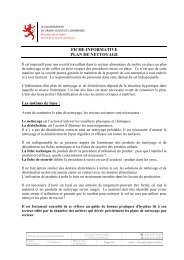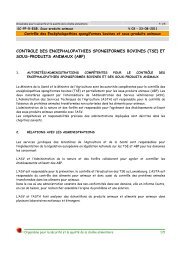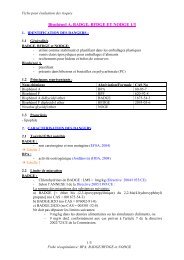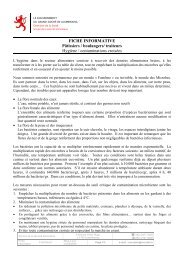Food contact materials
Food contact materials
Food contact materials
You also want an ePaper? Increase the reach of your titles
YUMPU automatically turns print PDFs into web optimized ePapers that Google loves.
<strong>Food</strong> <strong>contact</strong> <strong>materials</strong> - In-house documentation: Nordic check lists to industry and trade<br />
A. Introduction<br />
<strong>Food</strong> <strong>contact</strong> <strong>materials</strong> are a potential source of contamination of all types of foods. <strong>Food</strong>s are<br />
normally in <strong>contact</strong> with one or several types of food <strong>contact</strong> <strong>materials</strong>, like packaging, including<br />
multilayer <strong>materials</strong>, process equipment etc.<br />
<strong>Food</strong> <strong>contact</strong> <strong>materials</strong> shall comply with the legislation and in-house control in industry and<br />
trade is a tool to prevent violation of the legislation. Furthermore, in-house control are important<br />
pre-requisites to limit this contamination, e.g. in-house control based on declaration of<br />
compliance and documentation at the producers and importers.<br />
B. What are food <strong>contact</strong> <strong>materials</strong>?<br />
<strong>Food</strong> <strong>contact</strong> <strong>materials</strong> and articles (in the following abbreviated FCM) comprise a broad and<br />
complex area. Many different types of <strong>materials</strong> are used like plastics, paper, metals, woods,<br />
lacquers, adhesives, printing inks etc. The <strong>materials</strong> are used either as single <strong>materials</strong> or<br />
combinations e.g. in complex multilayer <strong>materials</strong>. Furthermore, many different substances<br />
are used in the <strong>materials</strong>, as e.g. monomers or additives like plasticizers, stabilisers, solvents<br />
and pigments. An estimation of the total number of chemicals used is 10.000’s and only lower<br />
percent of these chemicals have been assessed by the EU Scientific panels in EFSA 2) for the use<br />
in FCM and possible migration and potentials safety effect on consumer health.<br />
C. EU legislation<br />
Regulation no.1935/2004 on <strong>materials</strong> and articles intended to come into <strong>contact</strong> with foods<br />
is the framework regulation covering all types of FCM. The general requirements are as follows:<br />
FCM shall – under normal and foreseeable conditions of use – not transfer their constituents<br />
into foodstuffs in quantities, which could:<br />
a. Endanger human health<br />
b. Bring about an unacceptable change in the composition of the foodstuffs or<br />
c. Bring about de te ri o ration in the organoleptic characteristics thereof.<br />
This regulation applies to FCM, including active and intelligent FCM, which in their finished<br />
state are:<br />
a. Intended to be brought into <strong>contact</strong> with food; or<br />
b. Already brought into <strong>contact</strong> with food and are intended for that purpose; or<br />
c. Can reasonably be expected to be brought into <strong>contact</strong> with food or to transfer their<br />
constituents to food under normal or foreseeable conditions of use.<br />
The regulation does not apply to FCM which are supplied as antiques, covering or coating<br />
<strong>materials</strong>, such as the <strong>materials</strong> covering cheese rinds, prepared meat products or fruits,<br />
and which form part of the food and may be consumed together with this food nor to fixed<br />
public or private water supply equipment.<br />
In addition to the general legislation, EU has specific legislation on plastic, ceramics and<br />
regenerated cellulose and on good manufacturing practise at the producers of food <strong>contact</strong><br />
<strong>materials</strong> and the intermediates used for the production of FCM.<br />
The responsibility for observation of the legal requirements is on the producer, user or<br />
importer of FCM and processed and pre-packed food.<br />
An overview of the EU and Nordic legislation on FCM can be found on the relevant webpages,<br />
please see addresses below.<br />
2)<br />
European <strong>Food</strong> Safety Authority, former Scientific Committee for <strong>Food</strong><br />
4



